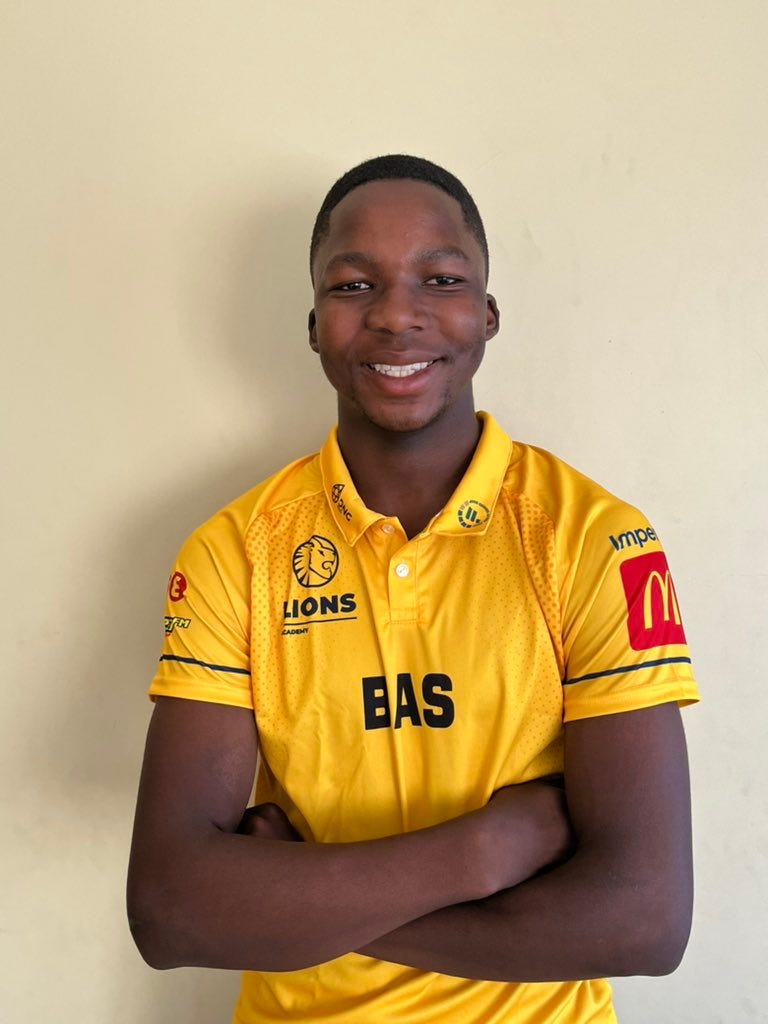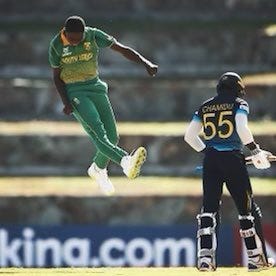Allan Donald, Andre Nel, Makhaya Ntini, Lance Klusenar, Shaun Pollock, Dale Steyn, Morne Morkel, Vernon Philander, Kagiso Rabada, Anrich Nortje, Lungi Ngidi… South Africa has a fast-bowling dynasty. A 16-year-old has set his sights on joining the list. This is a primer to his story:
If you are not a subscriber of Stumped!, join more than a thousand other professional athletes & ex-pros, coaches, commentators & analysts and casual sports fans that receive the newsletter in their inbox each week — it’s free:
I have seen the future of South African cricket. It was in a compilation of clips that I received. Temba Bavuma, the Proteas white-ball captain, did not have to sit through the compilation, he saw the future live. Not just that, he faced the future. It was fast.
While preparing for the Lions’ T20 triangular series against Namibia and Lahore Qalanders, Bavuma faced three successive deliveries, all just short of good length. They soared on the pitch and took him by surprise. Bavuma was impressed. The bowler was a 16-year-old boy, Kwena Maphaka.
The teenager has all the toys, he has in-swingers, cutters and bouncers.
“He is special. He has skill that is beyond his years. He bowls back of the hand slower deliveries and knuckle ball with precision,” says Prasanna Agoram Lions’ analyst.
And he has pace, lots of it too. Maphaka’s quest has always been to bowl as fast as he could. Faster than everyone around him. When he was seven years old, Maphaka was rattling nine-year-olds at Rivonia Primary School. When he was 11, Maphaka bowled a bouncer that broke a batter’s helmet grill.
Maphaka’s parents never played cricket and they did not watch it. Not before their sons started playing. They were more inclined towards football and athletics. They learned cricket through Tetelo. Maphaka was no different from his older brother, he loved the sport with the same intensity.
It’s no surprise that the boys’ games revolved around cricket. They had backyard duels. Indoors they either played mini-cricket matches with anything that could take the places of a bat and a ball. Hand them Lego blocks? They constructed cricket bats.
When they saw how much Maphaka loved the sport, they did with him what they previously did with Tetelo, they paid for lessons for him at DJ Coaching Academy. That accelerated his development.
Just as he did at home, Maphaka played up at DJ Coaching Academy. His speed made one forget that he was playing up. Maphaka’s first opponent, Tetelo, was six years older than him. Like most younger siblings, Maphaka has always wanted to be better than his older brother.
“My friends and I often competed to see who could bowl the fastest deliveries. Kwena always turned up for the competition. He believed that he was faster than all of us. He was never fussed by the fact that I am six years older than him,” says Tetelo Maphaka.
If you're enjoying this post, it would be awesome if you shared it with your friends. Thanks, as always, for supporting Stumped!
“Kwena loves to play cricket,” says Wim Jansen, St. Stithians’ first XI coach. “He loves it so much that sometimes he finds himself playing cricket seven days a week. That is an unacceptable situation.”
To help avoid such a situation, Maphaka now has a CSA-issued logbook. The logbook is connected to Cricket Clinic. Maphaka is required to make entries for every ball he bowls in the nets or matches. It helps him, his coaches and those close to him keep an eye on his workload. The logbook could be the ticket to a long career for the youngster.
“At St. Stithians we have 40 matches a year,” says Jansen. “Most schools play about 30 matches a year. We believe that players get better when they play more, that’s why we have more matches. But, Kwena also plays club cricket. That balloons his workload. Pace bowling takes a lot out of you, there is a high risk of injury and burnout. So, we end up having to pull him out of a lot of matches.”
Jansen is very protective of Maphaka, he sees a younger Kagiso Rabada in the youngster. Jansen would know, he also coached Rabada when he was at St. Stithians. According to Jansen, Rabada bowled at the same pace when he was 16.
During his years at St. Stithians, Rabada played rugby and participated in athletics. It was only in his senior year that he dropped everything else to focus on cricket. Maphaka is the number one seeded tennis player at St. Stithians, plays provincial tennis and is in the Gauteng Under-16 hockey team. Like Rabada, he is an allround sportsman.
Rabada also took his fitness seriously and was known to spend a lot of time in the gym. Like Rabada, Maphaka is not one of those youngsters ‘whom you must encourage to do strength and conditioning work.’ The similarities between Maphaka and Rabada are so many that Jansen and his team at St. Stithians are mirroring the regime they had for Rabada in Maphaka’s development.
Maphaka’s training drills contain a lot of leg and core work. Jansen also makes sure that Maphaka does a lot of swimming. Swimming is a non-weight-bearing and non-impact activity that is seen as an effective way to train. It offers an all-round workout and enhances joint mobility.
The only difference between Maphaka and Rabada is that Maphaka is a left-arm seamer. He looks like a left-handed version of the Proteas pacer.
This Substack column is reader-supported and exists thanks to patrons and readers that leave tips. If you enjoy the content, click the Subscribe button. And share the post with friends.
Shukri Conrad did not need a crystal ball to see what the future held in store for South African cricket. Seeing Kwena Maphaka bowl during an Under-15 match at a CSA Talent Acceleration Program camp at Fort Hare University, he knew he was watching the successor to the throne of the South African pace bowling dynasty in action.
Conrad attends these matches to keep an eye on the talent coming through provincial systems. He was blown away by what he saw. Maphaka had a quick arm action and looked dangerous bowling his beloved fuller length. It was almost clear from the outset that the teenager played club cricket against adults.
Later, during his time in the Under-19 set-up, Maphaka would master getting the ball to swing back into the right-handers under the instruction and watchful eye of Rory Kleinveldt.
“I spoke with him afterwards, he possessed a maturity that belied his age,” says Conrad. “That intelligence and maturity helped me make the decision to invite him to the Under-19 set-up. He was ahead of his peers.”
Vincent Barnes had the same reaction when he watched Maphaka bowl at the Under-19 camp a few months later. Barnes was standing behind the umpire. It was a good position to have a closer look at the bowlers. Barnes’ focus was on some of the other bowlers, the ones he knew. He was not prepared for the 15-year-old left-arm seamer who was running in and bowling incredibly quick. He had pace and accuracy.
In the Under-19 space, Maphaka more than held his own as a bowler, but when the coaching staff decided to take him along to the West Indies, the plan was not for Maphaka to play as many games as possible and be a match-winner.
Wim Jansen thought that Maphaka would probably only play a single game at the Under-19 World Cup - at most. A lot of people around Maphaka thought so too, Maphaka included. The experience allowed him to meet, Sir Curtly Ambrose, one of his idols. If he had not played a single game, Maphaka would have been happy because he got to meet Ambrose. His dream had already come true.
“We took him to the world cup more for the experience, for him to grow as a player, and for him to take that experience to the next world cup,” says Rory Kleinveldt, who was the Under-19 team’s bowling consultant. “Kwena understood that too, but that did not dampen his spirit, he was happy to be there. He worked hard, trained superbly before every game, and was a proper professional through it all. Kept his head up. Waited for his opportunity.”
The plan was to upskill Maphaka during the tour and maybe give him one match. South Africa’s Under-19 camp was hit by injuries and one match turned into three matches throughout the tournament. Maphaka did not disappoint. He bowled 23 overs and took seven wickets at an economy of 5.5 runs an over.
All things being equal, Maphaka will lead the bowling attack at the next Under-19 World Cup. He will take on that role as a 16-year-old.
“Kwena has grown into a more senior role in the Under-19 squad now that he has been to a world cup. He is now in the leadership group of the Under-19s,” says Kleinveldt.
Thank you for reading. I am entirely freelance and some very nice people help me to continue producing more content by donating a little here and there. Some do so by supporting my work on Patreon.
Others prefer to leave tips:
Others also support sharing posts that they enjoy. You can do all three.






